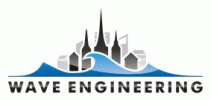The wave engineering team organised a series of field works, targeted to measurements of properties of ship wakes in Tallinn Bay and runup features of of ship-induced long waves. A preliminary series of measurements, with a total duration of 4 weeks, took place at the eastern breakwater of Lennusadam, about 2 km from Linnahall and 3 km from the passenger harbour. The water surface time series was sampled at a frequency of 5?Hz with the use of a downward-looking echsounder. The main part of the field works was performed near and at the island of Aegna for 21 June – 20 July. The studies comprised measurements of runup heights, recording of beach profile changes, identification of ship’s type, speed and distance to the study site, visual observations of the overall appearance of the ship wave systems, video recordings of the runup details, GPS-recordings of several tracks of fast ferries, numerical modelling of ship wake patters for realistic ship tracks, and studies of wave-induced changes of the optical properties of sea water.
The entire team, including PhD students at the Department of mechanics Andrus Räämet and Andres Kask, and several guests (prof. Kevin Parnell, prof. Efim Pelinovsky, dr. Tony Dolphin, dr. Ants Erm, among others) took part in the planning and practical organisation of the experiment, performing field measurements (which involved about 60 person-days spent at site), analysis of the data and writing of reports. The first publication – an overview of the performed studies and the basic conclusions about the properties of ship wakes and their impact on the coast – has been submitted to Estonian Journal of Engineering (Parnell et al. 2008). Detailed comparison of numerical simulations and experimental data and analysis of variability in spatial patterns of long nonlinear waves from fast ferries is presented in the paper, submitted to Nonlinear Processes in Geophysics (Torsvik et al.). ). At the time of writing, three conference papers, partially or entirely based on the results of the experiment have been presented already, and five papers have been accepted for oral presentations at the 10th International Coastal Symposium (Lisbon, April 2007).
One-day course (23.05.2008) accompanied with a two-day field trip (21–22.05) to the North Estonian coasts was organised in cooperation with Dept. of mechanics, Tallinn University of Technology. The key lectures were given by Prof. Efim Pelinovsky and Prof. Kevin Parnell.
The actions were reflected in media (V. Veski, Maaleht 7.08.2008), see Section „Media outreach”. All SEAMOCS team member participated
